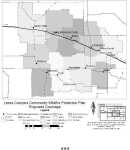Community Wildfire Protection Plan being developed

MILLIGEN, Neb. -- Ten fire districts in southwestern Nebraska will be the next area to have a Community Wildfire Protection Plan developed in the state. The development of a CWPP provides an avenue for community authorities, fire departments and residents to identify possible issues and remedies for communities and infrastructure at-risk from wildland fires.
Title I of the Healthy Forests Restoration Act defined and authorized Community Wildfire Protection Plans. It was passed by Congress on Nov. 21, 2003, and signed into law by President Bush on Dec. 3, 2003. A CWPP must be developed collaboratively and agreed upon by local government(s), local fire department(s), and the Nebraska Forest Service in consultation with interested parties and any Federal land management agencies in the vicinity.
The CWPP identifies and prioritizes areas for hazardous fuel reduction treatments and recommends types and methods of treatments that will protect one or more communities at risk and essential infrastructure. It also recommends ways to reduce structural ignitability, removing easily ignitable components on the structure(s) and it's immediate surroundings, throughout the at-risk community.
Don Westover, the Nebraska Forest Service (NFS) Fire Program Leader, initiated the CWPP process as the first step that would allow the agency to apply for grant funds which would be used to assist communities, agencies and landowners complete fuels reduction projects. "Since 2007, the NFS has assisted landowners in the Niobrara Valley and the Pine Ridge in thinning 11,375 acres of overly dense forested watersheds," said Westover. "Both programs reduced the risk of catastrophic wildfire and doubled grass production." Now the NFS would like to help landowners in the Loess Canyons area.
The project has been titled the Loess Canyons CWPP. The ten fire districts cover parts of Dawson, Frontier and Lincoln Counties. They are Brady, Cozad, Curtis, Eustis, Farnam, Gothenburg, Maxwell, Maywood-Wellfleet, North Platte, and Wellfleet. Local and County Government officials, Fire Chiefs, Emergency Managers, Nebraska Game & Parks, the Natural Resource Districts, Maranatha Bible Camp, which has expressed interest in fuel hazard reduction, have been contacted via mail -- electronic or postal service.
NFS has hired a forestry consultant, Kim Slezak, of Milligan to facilitate the Loess Canyons CWPP.
Slezak has 24 years of experience in forest management and wildland fire fighting, having worked for county, state and federal agencies in Missouri, Virginia, Arizona, and New Mexico before marrying a Nebraska farmer. At the time of leaving New Mexico State Forestry, Slezak, the first female State Timber Management Officer, oversaw all resource management areas including timber, urban forestry, seedling and entomology programs. All cutting prescriptions for hazardous fuels reduction projects were approved by Slezak before grant funds were allocated and work could begin.
"The encroaching Eastern redcedar and other plants, many non-native, have changed the fire ecology in the Loess Canyons area and Platte River riparian forest," Slezak said. "Hazardous fuels reduction projects can bring the areas back into a more natural fire regime and healthier ecosystems at the same time." A natural fire regime is the frequency and intensity a wildfire burns in a landscape in the absence of modern human intervention, which in grasslands is much different than one in a shrub or tree based area. The cedars have added 'heavy' fuels, burning hotter and longer than just grasses.
Likewise, cedar and Russian olive burn differently than cottonwood and willows in riparian forests. Contact Slezak via email (cwpp@slezakag.com) or the website set up to assist in the CWPP process, www.loesscanyons.slezakag.com. The site includes background information on the formulation of a CWPP; maps of the entire area and of each district showing historic fire activity. Residents can send comments via a Contact link; and community leaders/agencies were invited to complete a survey for background information to use in the CWPP.
Collaboration is imperative to achieve a true snapshot of conditions and resources at risk and to arrive at a workable CWPP that will benefit the Loess Canyons area. A draft version of the CWPP should be available in July. Comments will be taken on the draft plan on the website and at public meeting(s) in the CWPP area, which are yet to be scheduled.
